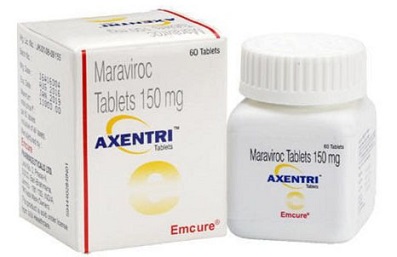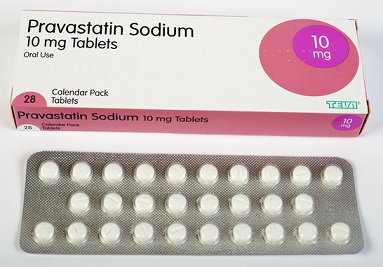U.S. Study Shows That The Drugs Maraviroc And Pravastatin Are Effective In Treating Long COVID By Targeting The Monocytic-Endothelial-Platelet Axis
Source: Long COVID Drugs Feb 14, 2022 3 years, 6 months, 2 weeks, 5 days, 7 hours, 28 minutes ago
Long COVID Drugs: A new American study involving researchers from the Californian biotech company incellDX and doctors from the
Chronic COVID Treatment Center In U.S. (
https://covidlonghaulers.com/), has found that the antiviral drug Maraviroc together with the cholesterol lowering medication Pravastatin, are effective in treating long COVID or PASC (Post-Acute Sequelae of COVID).

Maraviroc, sold under the brand names Selzentry (US) and Celsentri (EU), is an antiretroviral drug in the CCR5 receptor antagonist class used in the treatment of HIV infection. It is also classed as an entry inhibitor.
Pravastatin, sold under the brand name Pravachol among others, is a statin medication, used for preventing cardiovascular disease in those at high risk and treating abnormal lipids.
Dr Bruce Patterson, CEO & Founder of incellDX and the
Chronic COVID Treatment Center told Thailand
Medical News, “Long COVID or Post-acute sequelae of COVID (PASC), is a multisystem complication of SARS-CoV-2 infection that continues to debilitate millions worldwide thus highlighting the public health importance of identifying effective therapeutics to alleviate this illness.”
Dr Patterson who was previously the Medical Director of Diagnostic Virology at Stanford University Hospitals and Clinics further added, “The pathophysiology behind PASC may be attributed to the recent discovery of persistent S1 protein subunit of SARS-CoV-2 in CD16+ monocytes up to 15 months after infection. CD16+ monocytes, which express both CCR5 and fractalkine receptors (CX3CR1), play a role in vascular homeostasis and endothelial immune surveillance. We believe targeting these receptors using the CCR5 antagonist, maraviroc, along with pravastatin, could disrupt the monocytic-endothelial-platelet axis that may be central to the etiology of PASC.”
https://www.thailandmedical.news/news/breaking-ongoing-u-s-study-shows-persistence-of-sars-cov-2-s1-protein-in-cd16-monocytes-in-post-acute-sequelae-of-covid-19-up-to-15-months-post-infe
The
Long COVID Drugs study team utilizing five validated clinical scales (NYHA, MRC Dyspnea, COMPASS-31, modified Rankin, and Fatigue Severity Score) to measure 18 participants’ response to treatment.
The study team observed significant clinical improvement in six to twelve weeks on a combination of maraviroc 300mg PO BID and pravastatin 10 mg PO daily. Subjective neurological (p=0.002), autonomic (p<0.0001), respiratory (p=0.0153), cardiac (p=0.002) and fatigue (p<0.0001) symptoms scores all decreased which correlated with statistically significant decreases in vascular markers sCD40L and VEGF.
The study findings suggest that by interrupting the monocytic-endothelial-platelet axis, maraviroc and pravastatin may restore the immune dysregulation observed in PASC and could be potential therapeutic options
. This sets the framework for a future double-blinded, placebo-controlled randomized trial to further investigate the drug efficacy of maraviroc and pravastatin in treating PASC.
The study findings were published on a preprint server (Research Square) and are currently being peer reviewed.
https://www.researchsquare.com/article/rs-1344323/v1
The important discovery of CD16+ monocytes containing persistent S1 proteins from long COVID patients may help further understand its pathophysiology and identify targets for therapy.
Both CD16+ monocytes subsets, intermediate (CD14+CD16+) and nonclassical (CD14- CD16+), respectively, are known to interact significantly with the endothelium and platelets via the fractalkine pathway.
https://pubmed.ncbi.nlm.nih.gov/20004358/
Hence this implies that the pathophysiology of long COVID may lie with the monocytic-endothelial-platelet axis. Fractalkine, which mediates cell adhesion and leucocyte recruitment, is a transmembrane protein expressed in the brain, colon, heart, and lung, along with endothelial cells and astrocytes.
It has been found that intermediate monocytes express high levels of both CCR5 and fractalkine receptors, whereas nonclassical monocytes express high levels of fractalkine receptors. This interaction between fractalkine and fractalkine receptors have been involved in the pathogenesis of atherosclerosis, vasculitis, vasculopathies, and inflammatory brain disorders and could also be contributing to vascular endothelialitis in long COVID.
Importantly, vascular endothelialitis leads to collagen exposure along with platelet activation and adherence via glycoprotein 1b-IX-V-receptor (GPIb-IX-V) with collagen bound von Willebrand factor (vWF).
Activated platelets release soluble CD40 ligand (sCD40L) to recruit both neutrophils and monocytes to the vascular lesions, thus activating the coagulation cascade. Stimulated platelets also release RANTES which binds to endothelial cells and encourages monocyte adhesion to inflamed endothelial tissues and acts as a chemotactic agent for inflammatory cells.
https://pubmed.ncbi.nlm.nih.gov/11282909/
The activated platelets and endothelial cells can also secrete VEGF which induces angiogenesis and microvascular hyperpermeability. VEGF is a diagnostic marker for vasculitic neuropathy and also contributes to a pro-inflammatory-prothrombotic environment.
While the vascular effects of statins have been well documented, the protective role of maraviroc on the endothelium has also been similarly published.
https://pubmed.ncbi.nlm.nih.gov/32126319/
https://www.ncbi.nlm.nih.gov/labs/pmc/articles/PMC6446135/
The study team hence targeted CCR5 and fractalkine receptors on the S1 protein expressing CD16+ monocytes using maraviroc and pravastatin, respectively, hypothesizing that this combination could be therapeutically effective in treating vascular endothelialitis and resolving symptoms associated with long COVID.
The various neurological symptoms associated with long COVID include severe headaches and cognitive impairment (brain fog), along with neuropathy and weakness, necessitating the need for assistance in performing daily tasks.
Both CD14+CD16+ monocytes are known to transmigrate across the blood brain barrier and play an important role in central nervous system (CNS) immune surveillance. These monocytes were implicated as HIV reservoirs in the CNS causing neuroinflammation, neuronal damage, and cognitive defects.
https://pubmed.ncbi.nlm.nih.gov/29066542/
The study team hypothesized that the S1 protein containing CD14+CD16+ monocytes in long COVID patients are also crossing the blood brain barrier and triggering neuroinflammation and inducing neurological symptoms.
Both drugs maraviroc and statins are known to cross the blood-brain-barrier, and more specifically, maraviroc has been suggested as treatment for Parkinson’s, neurocognitive impairment, and strokes.
https://pubmed.ncbi.nlm.nih.gov/31043478/
Significantly, after the introduction of maraviroc and pravastatin, participants showed a decrease in modified Rankin scale scores (p=0.0002) and reported improvement in neurological function and ability.
These study findings were correlated with a statistically significant decrease in VEGF (r= 0.4, p=0.02) and sCD40L (r= 0.42, p=0.01), suggesting treatment targeting cytokines associated with vascular endothelialitis correlated with improvement in neurological symptoms.
Autonomic dysfunction such as postural orthostatic tachycardia syndrome (POTS) and light sensitivity has also been associated with long COVID.
POTS is a syndrome consisting of unexplained tachycardia, dizziness, light-headedness, fainting, and abdominal pain. While the true etiology of POTS has yet to be defined, endothelial dysfunction has been suggested as the pathophysiology. There is also evidence that POTS maybe be associated with G-protein coupled receptor autoantibodies.

Interestingly, since CCR5 and fractalkine receptor are also G-protein-coupled receptors, it is possible that antagonism of these receptors could also inhibit the autonomic effects of these autoantibodies.
The study team observed a statistically significant decrease in COMPASS-31 (p=0.0001) scores correlating with statistically significant decreases in VEGF (r=0.6, p=0.0005), sCD40L (r=0.6, p=0.0001), and TNFalpha (r=0.5, p=0.0026), suggesting that pro-inflammatory macrophage activation may be triggering vascular endothelialitis.
Interestingly, elevations in sCD40L have also been associated with sympathoadrenal activation and targeting these vascular markers may address long COVID associated dysautonomia. Cardiorespiratory complaints such as chest pain, shortness of breath, and symptoms resembling POTS are very commonly reported by long COVID patients.
Many long COVID patients with cardiac and pulmonary symptoms have undergone extensive workup (EKG, echocardiogram, stress test, pulmonary function testing, etc.) which have not detected any abnormalities or pathologies.
Subsequently, current clinical approaches have only been used to treat symptoms with antiarrhythmics, bronchodilators or alpha-adrenergics, instead of addressing the underlying pathophysiology.
The study team observed an improvement in cardiac symptoms evidenced by a decrease in NYHA functional classification (p=0.002).
This improvement was associated with statistically significant decreases in IL-8 (r=0.4, p=0.03) and GMCSF (r=0.4, p=0.01).
Importantly, endothelial cells are main producers of IL-8 and statins are known to decrease IL-8. Additionally, maraviroc has been suggested as reducing the cardiovascular risk for acute coronary disease by protecting the endothelium from pro-inflammatory macrophage infiltration.
These mechanisms potentially support their use in addressing long COVID associated cardiac symptoms.
The study team also observed improvement in respiratory symptoms after initiating maraviroc and pravastatin therapy.
Study participants reported improvements as reflected by a statistically significant decrease in the MRC Dyspnea scale (p=0.0153). These responses and improvements correlated with statistically significant decreases in IL-2 (r=0.4, p=0.05), GM-CSF (r=0.6, p=0.0002), sCD40L (r=0.4, p=0.04), and TNF-alpha (r=0.4, p=0.01).
Intriguingly, CD16+ monocytes are known to produce large quantities of TNFalpha and could be activated by the retained S1 proteins, causing vascular endothelialitis via the fractalkine-fractalkine receptor interaction in pulmonary vasculature.
https://pubmed.ncbi.nlm.nih.gov/11907116/
Elevations in sCD40L have been associated with pulmonary arterial hypertension (PAH), while IL-2 can induce pulmonary microvasculature injury and generate an asthma-like bronchoconstriction.
The study team previously published a multi-class model score that described an increase IL-2 as a characteristic specific to long COVID, thus confirming the clinical significance of IL-2 in long COVID.
Importantly both maraviroc and statins can decrease IL-2 and TNF-alpha which may explain the observed improvements in long COVID associated respiratory symptoms. The patient Fatigue Severity Score (FSS) also significantly decreased (p with maraviroc even after 96 weeks of treatment at the FDA approved dose of 300mg B.I.D.
It was this that influenced the study team’s decision to treat with this dose.
Lover safety was monitored in all the participants by measuring and evaluating AST, ALT, and total bilirubin (LFTs) prior to commencing treatment with maraviroc and every two weeks while on treatment. None of participants presented here experienced any clinical signs of hepatotoxicity or elevated liver function serologies while on, or after, treatment.
Maraviroc is metabolized by CYP3A4, and the study team had chosen to avoid any CYP3A4 metabolizing statins to mitigate any potential drug interactions.
This approach guided their decision to treat with pravastatin 10mg PO daily over the other statins since it is metabolized via glucuronidation.
As some of the participants were already on other therapeutics including ivermectin, fluvoxamine, and prednisone, all the biomarker data and subjective responses were documented from the initiation of maraviroc and pravastatin.
Interestingly some participants saw symptom relief after six weeks and were ready to stop all medications, while others needed treatment up to twelve weeks before discontinuing medications.
The study team said that further studies will need to be conducted to understand this variation in length of treatment between participants.
The study team concluded, “The study findings we present in this case series do not replace the need for a double-blinded placebo controlled randomized trial to understand drug efficacy. However, we do believe this case series sets the framework for such future clinical trial designs to further investigate the efficacy and usefulness of maraviroc and pravastatin to treat long COVID”.
For more on
Long COVID Drugs, keep on logging to

